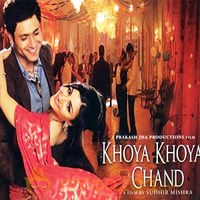
Khoya Khoya Chand Movie Reviews
| Starring | Shiney Ahuja, Soha Ali Khan, Rajat Kapoor, Sushmita Mukherjee |
|---|---|
| Music | Shantanu Moitra |
| Director | Sudhir Mishra |
| Producer | Prakash Jha |
| Year | 2007 |
| Rating |
Khoya Khoya Chand Review
by MyMazaa.comThe film is set between 1953 and 1965. Junior artiste Nikhat (Soha Ali Khan) goes through multiple casting couches from the age of 14 till she catches the attention of top star Prem Kumar (Rajat Kapoor) who gets her a big break. He also patronizes Zafar (Shiney Ahuja), a writer from an aristocrat family that has fallen on bad days thanks to his debauched father, whom Zafar could not forgive even on the latter€™s deathbed.
Zafar €˜repairs€™ a script that Prem Kumar is sure will be a disaster and becomes Prem€™s favourite, and this film (with Nikhat) proves a hit, bringing out the worst in top heroine Ratna (Sonya Jehan) who becomes terribly insecure. But due to constant interaction Nikhat and Zafar come close and get into a relationship. Considering Nikhat like his property, Prem is livid and drops them both from his new film. But the director quits Prem€™s film, signs Nikhat and Zafar and delivers a hit.
After that comes turbulence. Zafar wants to film his life€™s traumatic story and turn director. His marriage to Nikhat has been called off due to the latter€™s commitments and she opts out of his film too. Zafar signs Ratna but the film bombs. Nikhat goes back to Prem and a film is signed. But she starts drinking. A whole lot of confusing reels later, she dies €“ of a hole in the heart! But not before Zafar directs his own triangular love saga with (once again) Prem Kumar and Nikhat in their real-life roles, and exorcises the ghost of his father haunting him for not having forgiven him. And the show goes on€¦
Every story should have a purpose (not necessarily a message) and direction. But Sudhir Mishra€™s story and script seem directionless and pointless. What is he trying to project in this film? Is this just an indulgent tribute to cinema of the past? If that€™s so, the detailing is authentic and the caricature characters are well-etched (especially the Punjabi producer stereotype and the Bengali director). The sets, the costumes, make-ups, sets and the sets shown within and of course the songs (great job by Shantanu Moitra but hardly exploited in the film) and background score (Shantanu again) are well-researched and apt. And yes, the lyrics (Swanand Kirkire) are outstanding.
But as a human drama, as a look at the lives of junior artistes, top stars and the workings of the film world, this film works only partly. You can, for example, empathize with Nikhat throwing stones at the cad producer to whom she lost her virginity at 14, but the Zafar-father angle sucks and is overdrawn. The twists and turns in who has broken off and patched up or is sleeping with whom become confusing and frankly, by that time, you do not care.
The attempt to make Nikhat have shades of Meena Kumari (alcoholism, fragmented multiple relationships), Madhubala (a hole in the heart and a sob story) and a traumatic past fails, partly because Soha Ali Khan lacks the maturity to bring in the nuances but mainly because of the poor script that fails to evoke sympathy for its protagonists.
If Mishra€™s script (barring some excellent spoken lines and parts of the first half of the film) is disappointing, his directorial expertise is erratic and there are few punches. The editing (Archit D.Rastogi and Ruchi Narain) vacillates between jerky (suggesting over-shooting) and soporific and the second half is tedious where one keeps expecting the film to end for a full twenty minutes before it does.
Another handicap is the miscasting. Once again, the role of Nikhat needed a more experienced artiste even if Soha tries her best and does justice to several sequences. Shiney is dull (pun intended) and beyond a point (say the first 30 minutes) his monotone, single junkie-like expression and non-performance begin to grate. Rajat Kapur hams, as he is meant to. But he can in no way epitomize a top star. Sonya surprisingly makes a mark, Sourabh Shukla hams too, and the rest of the cast is strictly average.
But Vinay Pathak is wasted, just like the time we spend going to the movie hall, watching the film and coming home, when we could spent it in more fruitful ways, like revisiting classics like Kaagaz Ke Phool (also based on the film industry) or any great films of the past.










